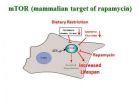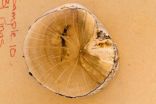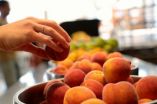(Press-News.org) DALLAS – May 20, 2014 – A lean "Supermodel" mouse type has revealed the potentially critical role played by a largely unknown gene that regulates metabolism, findings that could provide new insight into diseases ranging from diabetes to obesity, a new study by UT Southwestern Medical Center researchers suggests.
The Supermodel mouse's phenotype – the physical characteristics that result from its gene makeup – include being very small in size, with an unusual body form caused by abnormal distribution of fat, said Dr. Zhe Chen, Assistant Professor of Biophysics, and Dr. Bruce Beutler, Professor of Immunology, with UT Southwestern's Center for the Genetics of Host Defense. The mouse phenotype is nicknamed "Supermodel."
"This mouse is important because it has revealed a new regulatory protein that's very important for normal metabolism, but was never known to exist before," said Nobel Laureate Dr. Beutler, Director of the Center for the Genetics of Host Defense. "The implications of the work may be felt in diabetes and obesity research, the study of wasting in chronic disease, the study of muscle cell function, and perhaps other fields."
While at the Scripps Research Institute, Dr. Beutler developed a mouse mutagenesis program, which at UT Southwestern has become the largest and most technologically advanced in the world. The new mouse phenotype was discovered in the lab's colony of mutant mice several years ago, but the mutation was discovered and studied entirely at UT Southwestern, in a collaboration that also involved researchers Dr. William Holland, Assistant Professor of Internal Medicine, Dr. Aktar Ali, Assistant Professor of Internal Medicine, and John Shelton, lab manager in Internal Medicine. Together, they found that a mutation in a gene called Samd4, about which almost nothing was known in mammals, results in the abnormally lean mice, which also have diminished insulin responses to glucose and arginine.
"Whereas many heritable obesity phenotypes are known, lean phenotypes are comparatively uncommon. Yet they can reveal critical checkpoints regulating energy balance," the researchers said.
The mice seem to waste energy, consuming excessive oxygen and producing a commensurately higher amount of CO2, despite being relatively inactive. Much of the fat in these mice seems to be abnormal, similar to "brown fat" of hibernating species.
The findings, appearing in the Proceedings of the National Academy of Sciences, may be explained by the apparent involvement of Sterile alpha motif domain containing protein 4 (Samd4) in a specific cell signaling pathway, which tell cells how to interact, called mTORC1. mTORC1 is a master regulatory complex that governs aspects of energy balance, including metabolism, development, autophagy (cell recycling), and other processes in cells.
INFORMATION:
Dr. Bruce A. Beutler shared the 2011 Nobel Prize in Physiology or Medicine with two other scientists for their discoveries related to activation of the immune system.
About UT Southwestern Medical Center
UT Southwestern, one of the premier academic medical centers in the nation, integrates pioneering biomedical research with exceptional clinical care and education. The institution's faculty includes many distinguished members, including six who have been awarded Nobel Prizes since 1985. Numbering more than 2,700, the faculty is responsible for groundbreaking medical advances and is committed to translating science-driven research quickly to new clinical treatments. UT Southwestern physicians provide medical care in 40 specialties to nearly 91,000 hospitalized patients and oversee more than 2 million outpatient visits a year.
'Supermodel' mouse reveals mechanisms that regulate metabolism, researchers find
2014-05-20
ELSE PRESS RELEASES FROM THIS DATE:
Research explains action of drug that may slow aging and related disease
2014-05-20
CORVALLIS, Ore. – A proven approach to slow the aging process is dietary restriction, but new research in the Linus Pauling Institute at Oregon State University helps explain the action of a drug that appears to mimic that process – rapamycin.
Rapamycin, an antibiotic and immunosuppressant approved for use about 15 years ago, has drawn extensive interest for its apparent ability – at least in laboratory animal tests – to emulate the ability of dietary restriction in helping animals to live both longer and healthier.
However, this medication has some drawbacks, including ...
Shrub growth decreases as winter temperatures fluctuate up
2014-05-20
Many have assumed that warmer winters as a result of climate change would increase the growth of trees and shrubs because the growing season would be longer. But shrubs achieve less yearly growth when cold winter temperatures are interrupted by temperatures warm enough to trigger growth.
"When winter temperatures fluctuate between being cold and warm enough for growth, plants deplete their resources trying to photosynthesize and end the winter with fewer reserves than they initially had. In the summer they have to play catch up," said Melanie Harsch, a University of Washington ...
Game changer: Patients of doctors who played online game had better control of blood pressure
2014-05-20
Boston, MA – Primary care providers who engaged in an online game to solve clinical cases about hypertension management improved blood pressure control of their patients in a shorter amount of time compared to non-gamers, according to a new study by researchers at Brigham and Women's Hospital (BWH) and the Veterans Affairs Boston Healthcare System.
The study was published May 20, 2014 in Circulation: Cardiovascular Quality and Outcomes.
"This study is the first to show that an online educational game among medical professionals can improve the health measures of their ...
Screen of existing drugs finds compounds active against MERS coronavirus
2014-05-20
WHAT:
Clinicians treating patients suffering from Middle East respiratory syndrome (MERS) currently have no drugs specifically targeted to the MERS coronavirus (MERS-CoV), a virus first detected in humans in 2012 that has since caused 614 laboratory-confirmed infections, including 181 that were fatal, according to the World Health Organization. The case count escalated sharply in the spring of this year, and the first cases in the United States were announced in early May. To address the urgent need for therapies, researchers supported by the National Institutes of Health ...
Detroit Lions help rebuild city with innovative gridiron giving, U-M researchers say
2014-05-20
ANN ARBOR—The Detroit Lions' new model of philanthropy and community engagement may prove to be a touchdown for the city of Detroit.
A new case study of corporate social responsibility in sport by University of Michigan researchers uses the Lions as an exemplar of a professional sports team reinventing its charitable giving and community relations approach in hopes of making a bigger impact on the community.
In 2012, the Lions created the "Living in the City" campaign—a new model of corporate philanthropy that emphasizes deeper relationships with a small core group ...
UofL researcher and team explore broader definition of successful aging
2014-05-20
LOUISVILLE, Ky. – An aging population poses challenges for governments around the globe as nations grapple with how to satisfy the physical, social and economic needs of older adults. About 126 million adults 65 years and older live in China - the country with the largest population of senior citizens, while 40 million adults 65 years and older live in the United States.
In an article published today in Journal of Transcultural Nursing, University of Louisville School of Nursing assistant professor Valerie Lander McCarthy, PhD, RN; Ji Hong, MSN, a visiting scholar from ...
With climate changing, southern plants outperform northern
2014-05-20
Can plants and animals evolve to keep pace with climate change? A study published May 19 in the journal Proceedings of the National Academy of Sciences shows that for at least one widely-studied plant, the European climate is changing fast enough that strains from Southern Europe already grow better in the north than established local varieties.
Small and fast-growing, Arabidopsis thaliana is widely used as the "lab mouse" of plant biology. The plant grows in Europe from Spain to Scandinavia and because Arabidopsis is so well-studied, there is a reference collection of ...
The added value of local food hubs
2014-05-20
(Santa Barbara, Calif.) — As the largest purchaser of wholesale produce in Santa Barbara County, UC Santa Barbara's residential dining services provided the perfect avenue for a pilot project incorporating local pesticide-free or certified organic produce into an institutional setting.
The idea was conceived almost 10 years ago, when a group of students approached environmental studies professor David Cleveland about becoming a faculty adviser for student-led sustainable living classes. The group wanted to explore how to bring more local organic food in the dining halls. ...
Central Valley sees big drop in wintertime fog needed for fruit and nut crops
2014-05-20
BERKELEY — California's winter tule fog -- hated by drivers, but needed by fruit and nut trees -- has declined dramatically over the past three decades, raising a red flag for the state's multibillion dollar agricultural industry, according to researchers at the University of California, Berkeley.
Crops such as almonds, pistachios, cherries, apricots and peaches go through a necessary winter dormant period brought on and maintained by colder temperatures. Tule fog, a thick ground fog that descends upon the state's Central Valley between late fall and early spring, helps ...
New analysis eliminates a potential speed bump in quantum computing
2014-05-20
A quantum particle can search for an item in an unsorted "database" by
jumping from one item to another in superposition, and it does so
faster than a classical computer ever could.
This assertion assumes, however, that the particle can directly hop from any item to any other. Any restriction on which items the particle can directly hop to could slow down the search.
"Intuition says that a symmetric database allows the particle to hop freely enough to retain the quantum speedup, but our research has shown this intuition to be false," says Tom Wong, a physicist at ...







